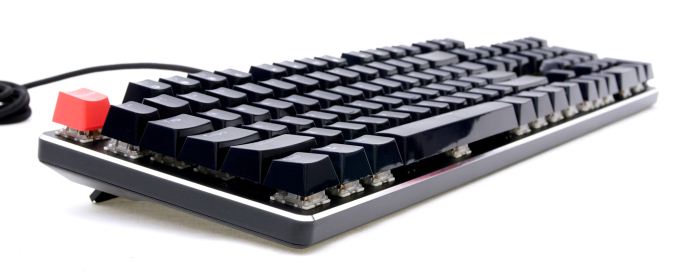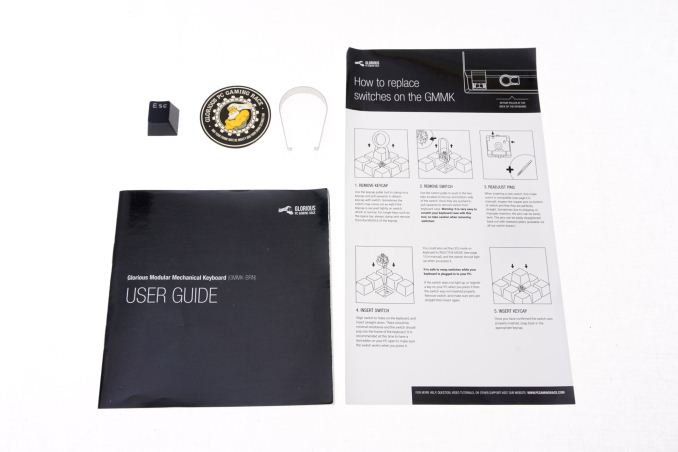The Glorious PC Gaming Race GMMK-BRN Modular Mechanical Keyboard Review
by E. Fylladitakis on November 1, 2016 10:00 AM EST
The popularity of mechanical keyboards has been rising sharply during the last few years, leading not only to the release of new keyboards from almost every company that is involved in the production of PC hardware, but to the emergence of many startup companies as well. This however has saturated the market, with very few new products actually bringing new, innovative features into the quickly maturing market. Most of the companies are nowadays trying to compete in terms of physical design and aesthetics.
One of the newest startup companies that entered the world of PC gaming peripherals is Glorious PC Gaming Race LLC. The company was founded in 2014 - their name intentionally paying homage to Reddit's popular PC Master Race gaming community - with the purpose of delivering high quality but competitively priced gaming peripherals for the aforementioned enthusiast PC gaming user base. Glorious PC Gaming Race LLC is based in Utah, USA.
In this review we will be having a look at the GMMK-BRN Modular Mechanical Keyboard, the first and only mechanical keyboard that Glorious is currently producing. While the keyboard looks very simplistic at first sight, it is capable of having its switches removed and replaced by the user. This is only the second keyboard that we have seen making use of this feature after the Epicgear Defiant, and there is a major difference: Glorious PC Gaming Race claims that any Cherry MX switch, original or clone, can be used with the GMMK-BRN, not just their own.
Packaging & Bundle
Glorious PC Gaming Race supplies the GMMK-BRN in a simple cardboard box. The artistic theme is black and white, focused on a schematic of the keyboard and highlighting its most important feature: the modular switches. It is a very sturdy box and polystyrene foam slabs protect the keyboard inside it, ensuring safe shipping
Inside the box we found a basic user’s guide, a guide on how to replace the switches (which, strangely, is also included in the main guide anyway), a round sticker, a metallic switch puller and a standard ESC keycap.












37 Comments
View All Comments
jeffbui - Tuesday, November 1, 2016 - link
Best first comment, could not write betterMr Perfect - Tuesday, November 1, 2016 - link
Replaceable switches are a cool concept. If a switch goes bad or gets dirty on most boards, you have to desolder it and solder on a new one. Most people can't do that. This also gives people the option to use unusual switch types, like clears or greens that no one seems to want to make boards out of. It's to bad that they're contact pads and not sockets though.Also, how many simultaneous key presses is this? 6 or full NKRO?
warrenk81 - Tuesday, November 1, 2016 - link
Did i miss the page where you demonstrated the headline feature? or was it just the two pictures?Ryan Smith - Tuesday, November 1, 2016 - link
Just the two pictures.DanNeely - Tuesday, November 1, 2016 - link
I'm still not a big fan of illuminated desktop keyboards, but moving the marking so both characters were side by side on the top and well illuminated looks a lot better than what I've seen on other recent ones where the bottom symbol was a steady clear/white color that clashed with the rest of the keys.mtbiker731 - Tuesday, November 1, 2016 - link
These copy/paste keyboard articles are getting incredibly repetitive. Can you at least try out some effort in not copying your words verbatim from the last 10 keyboard articles?? Maybe the companies sending you this stuff for review will start to pick up on your lazy tactics. Until then, I refuse to click on another keyboard article, or even consider purchasing one of these things."Final Words
I always try to use every keyboard that we review as my personal keyboard for at least a week. My typical weekly usage includes a lot of typing (about 100-150 pages), a few hours of gaming and some casual usage, such as internet browsing and messaging."
Where have I read that before...
Ryan Smith - Wednesday, November 2, 2016 - link
The purpose of doing so is to lay out the subjective aspects of our keyboard testing methodology. But I do see your point. It's not going to go away entirely, but maybe we can do something a bit different...Manch - Wednesday, November 2, 2016 - link
Could you just do a keyboard round up instead of a separate article?FUBARette - Wednesday, November 2, 2016 - link
Would anyone care to help me understand the advantages of this latest trend in tall mechanical keys with lengthy travel for gamers as opposed to the shorter chicklet keys? I know a lot of folks loathe chicklet keys with the heat of a thousand burning suns, but they're not going back to the Compaq keyboards of yore with keys so high they cast a farking shadow.I'm a former medical transcriptionist who was paid to type as fast and accurately as possible without ever looking down at the keyboard. When medical transcription started in the late 1980s, the keys were taller than the Empire State Building and required the strength of Godzilla to mash them quickly and accurately. I've long since moved on to tech support of hospital servers and MT workstations, but am baffled by what is, to me anyway, a new trend for sky-high keys and lengthy key travel.
Please for to explain this phenomena of towering keys. What are the gains? Is it just a trend that shall fade or is it here to stay?
Lord of the Bored - Wednesday, November 2, 2016 - link
The full-height keys enable the use of a larger switch with a longer travel and smoother action than the silicone rubber domes necessary for the small chiclet keys.The alleged advantage is that the keystroke resistance is even through the entire travel instead of all the force being at the beginning and then the finger "falling through" to the bottom when the dome collapses, so you aren't pounding fingertips against a hard surface all the time because of it.
Personally, most silicone dome switches just feel terrible to me. Some are better than others, though they all feel kinda mushy after using a microswitched board for some time.
I hadn't noticed chiclet keys ever becoming the standard for standalone keyboards. They tend to only show up where space is at a premium and there isn't room for full-height keys.
But everything old is new again. We came out of another "make the keyboard cheaper" trend and are in a "make the keyboard good" phase. There is no elimination of the low-profile boards, but the market IS focusing on full-size microswitched boards lately.